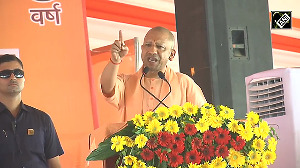"In India, the penetration level is just 25 per 1000 watches compared to a global average of 250 watches per 1000 people.
According to a recent study, 600 million people in India do not wear watches a vast market which can be tapped," says Harish Bhatt, president, All India Federation of Horological Industries.
"The Indian economy may be growing, but it cannot be said so of the watches sector. During 2002, the industry showed a negative growth of -5.7 per cent, though in 2003, it improved to 4.1 per cent," he says.
The watch industry has blamed the slow growth rate to increase in the rate of abatement by the government to 50 per cent, cut in excise duty and curbing of illegal imports.
The All-India Federation of Horological Industries argued that the present rate of abatement of 35 per cent is not justifiable. "The manufacturing cost now is only 50 per cent of the maximum retail price but we continue to pay excise duty on 65 per cent of the MRP," says Bhat.
There has been a steep increase in excise duties on watches from rates varying between eight per cent and 16 per cent in 1999-2000, to uniform 16 per cent now. The exemption provided for lower-end watches has also been withdrawn.
The federation has demanded that the excise duty be cut on watches costing more than Rs 500 and completely abolished on others. V D Wadhwa of Timex Watches says the industry has sought urgent government intervention to achieve the target of "one watch per person".
The industry has sought government's assistance to increase the affordability of watches for the common man and improve the performance of the watch industry, he says, adding the industry has the capability of catering to the gigantic consumer base of 1.2 billion.
As of today, India has more than 20,000 watch retailers. More than 500,000 people are directly or indirectly employed in the industry.
"The VAT on the watch and watch components stands at 12.5 per cent which used to be eight per cent earlier. Reduction in sales tax will help the masses to buy watches at an affordable prices. Sales tax has risen significantly with the states adopting a uniform rate of 12.5 per cent sales tax and few others charging still higher rates, due to deferment of introduction of VAT," says Wadhawa.
According to industry estimates, the total investment in the organised watch sector is $218 million. Out of a total demand of more than 30 million units, the organised sector supplies only 14 million units valued at $203 million. The number of watches imported legally is miniscule while the size of the unorganised sector is around $232 million.






 © 2025
© 2025